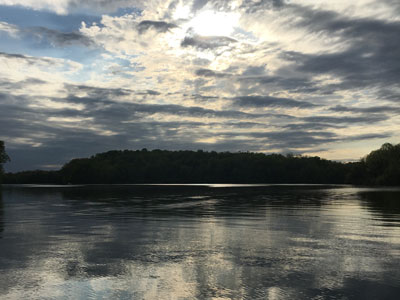
In Pennsylvania, Blue Marsh Lake is an impoundment of Tulpehocken Creek, a tributary to the Schuylkill River. Water flow is controlled by a dam on Tulpehocken Creek. The lake is operated by the U.S. Army Corps of Engineers (ASACE). Its primary purpose is to provide flood control to part of the Schuylkill River Valley.
Blue Marsh Lake has become an important recreational area for southeastern Pennsylvania. The lake contains more than 1100 acres of water for fishing, boating, paddlesports, and other recreation. Nearby are the communities of Reading, Bernville, and North Heidelberg. The lake is within day trip range of Harrisburg, Allentown, and Philadelphia.
Feeding the lake at its northern tip are Northkill Creek ,Little Northkill Creek, Tulpehocken Creek, and several smaller tributaries. Along its eight mile length, Licking Creek and numerous small streams feed the lake.
Public access to the Blue Marsh Lake is available at numerous locations. Three boat launches provide access to the lake for launching. On the upper lake, Sheidy Boat Launch is operated by the Pennsylvania Fish and Boat Commission. The U.S. Army Corps of Engineers operates Dry Brooks and State Hill Boat Launches on the lower lake.
Surrounding the lake is Blue Marsh Lake Recreation Area, a 5000 acre parcel of public land tracts including Federal land, State Games Land 280, north and south parcels, Blue Marsh Lake Park, and others.
Alongside the lake, 36 miles of trails are popular areas for hiking, biking, walking, cross country skiing, horseback riding, wildlife watching, and other activities. The trails are part of the Greater Reading Trail System.
Blue Marsh Lake fish species include hybrid striped bass, largemouth bass, smallmouth bass, black crappie, white crappie, sunfish, muskellunge, tiger musky, walleye, yellow perch, carp, white suckers, flathead catfish, channel catfish, and brown bullheads. In 2022, anglers reported catching northern snakeheads in Blue Marsh Lake.
Several streams and other tributaries that feed the lake contain brook trout, brown trout, fallfish, suckers, and other native and introduced fish species.
Depths in the lake vary to 53 feet. Much of the shoreline is steep, with an abundance of fallen timber. To supplement natural structure, Pennsylvania Fish and Boat Commission has deployed a variety of artificial reef materials throughout the lake. During winter, when ice conditions allow anglers to safely access the lake, ice fishing can be productive.
Below the Blue Marsh Lake stilling basin, the Tulpehocken Creek tail waters are considered one of the best trout fisheries in southeastern Pennsylvania. The Tully is stocked with rainbow and brown trout.
The tailwater section of the Tully is also noted for its walleye fishing. Other fish species along this stretch include smallmouth bass and rock bass.
Several trails, parks, overlooks, recreation areas, and other access points are located along the creek between the dam and the community of Reading. Stretches of Tulpehocken Creek above and below Blue Marsh Lake have earned state-designated scenic river status.
Near Reading, Tulpehocken Creek converges with the Schuylkill River. The USGS maintains stream gauges along Tulpehocken Creek.